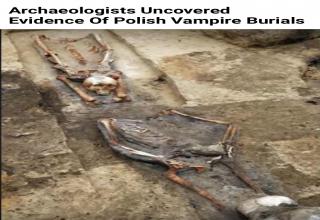Unusual Burials From The Depths Of History's Vault
Kenneth Coo
Published
09/17/2018
in
wow
Just in time for Halloween.
- List View
- Player View
- Grid View
Advertisement
-
1.
 Three 14th-century bodies excavated in Poland showed clear signs of posthumous mutilation. Fear of vampires is the likeliest reason. The remains had been decapitated, punctured at the spine, and had their heads wedged between heavy stones. Folklore of the times prescribed such violent measures to prevent the dead from rising again. It’s likely the victims suffered from diseases in life that caused them to be singled out as supernatural or evil in some way. According to researchers, the victims suffered from kyphosis, an unnatural rounding of the back and a deformation some might have attributed to them being vampires. Others may have suffered from cholera.
Three 14th-century bodies excavated in Poland showed clear signs of posthumous mutilation. Fear of vampires is the likeliest reason. The remains had been decapitated, punctured at the spine, and had their heads wedged between heavy stones. Folklore of the times prescribed such violent measures to prevent the dead from rising again. It’s likely the victims suffered from diseases in life that caused them to be singled out as supernatural or evil in some way. According to researchers, the victims suffered from kyphosis, an unnatural rounding of the back and a deformation some might have attributed to them being vampires. Others may have suffered from cholera. -
2.
 In 2016, a group of at least 80 skeletons were found buried in Greece, all with iron shackles on their wrists, arranged in neat rows. "They are all tied at the hands with handcuffs and most of them are very, very young and in a very good state of health when they were executed," said Stella Chryssoulaki, the head of the excavation site. Their unusual method of burial suggests they were more than just everyday criminals. Circa 640 BC, a disgruntled former athlete-turned-tyrant named Cylon led a coup attempt in Athens. His attempt failed, and Cylon fled unharmed. However, researchers suggest these shackled skeletons may have been the bodies of his supporters and allies, who weren't so lucky.
In 2016, a group of at least 80 skeletons were found buried in Greece, all with iron shackles on their wrists, arranged in neat rows. "They are all tied at the hands with handcuffs and most of them are very, very young and in a very good state of health when they were executed," said Stella Chryssoulaki, the head of the excavation site. Their unusual method of burial suggests they were more than just everyday criminals. Circa 640 BC, a disgruntled former athlete-turned-tyrant named Cylon led a coup attempt in Athens. His attempt failed, and Cylon fled unharmed. However, researchers suggest these shackled skeletons may have been the bodies of his supporters and allies, who weren't so lucky. -
3.
 Peruvian Trophy Heads The nearly 1,500-year-old remains of at least 60 people and six trophy heads have been discovered in deep pits in Vitor Valley in southern Peru. Due to the arid climate, some of the remains became naturally mummified, their flesh surviving without the need for artificial mummification. Besides the normal burial pits, the archaeologists found that the trophy heads, which had been cut off from the bodies after death. Trophy heads have been found at other sites in Peru and may be the heads of enemies killed in battle. However, since these was found next to the ordinary burials, the heads found in these pits may be people who lived in the same community and were killed in an outside battle. One theory is that they belong to combatants of the same group and carrying the whole skeletons back would have been much more work, so their comrades brought the heads back from the battlefield so they could be buried with people from their own community.
Peruvian Trophy Heads The nearly 1,500-year-old remains of at least 60 people and six trophy heads have been discovered in deep pits in Vitor Valley in southern Peru. Due to the arid climate, some of the remains became naturally mummified, their flesh surviving without the need for artificial mummification. Besides the normal burial pits, the archaeologists found that the trophy heads, which had been cut off from the bodies after death. Trophy heads have been found at other sites in Peru and may be the heads of enemies killed in battle. However, since these was found next to the ordinary burials, the heads found in these pits may be people who lived in the same community and were killed in an outside battle. One theory is that they belong to combatants of the same group and carrying the whole skeletons back would have been much more work, so their comrades brought the heads back from the battlefield so they could be buried with people from their own community. -
4.
 Plague pits in Great Britain. When the Bubonic plague (a.k.a. “Black Death”) ravaged Europe in the 14th century, traditional burial methods had collapsed under the weight of one-to-two-thirds of Europe in corpses. This kind of practice became standard procedure in times of plague, such as when plague struck again in England in the form of the Great Plague of 1665 (this time killing 100,000 people, which is about 20% of London’s population).
Plague pits in Great Britain. When the Bubonic plague (a.k.a. “Black Death”) ravaged Europe in the 14th century, traditional burial methods had collapsed under the weight of one-to-two-thirds of Europe in corpses. This kind of practice became standard procedure in times of plague, such as when plague struck again in England in the form of the Great Plague of 1665 (this time killing 100,000 people, which is about 20% of London’s population). -
5.
 Rosalia Lombardo was an Italian girl born on Dec. 13, 1918. She died less than two years later on Dec. 6, 1920, of pneumonia. Her father grieved her loss so profoundly, he made arrangements to have her preserved. Her corpse was mummified and she still lies encased in glass at the Capuchin Catacombs in Palermo, Italy, for the world to view. Although the photograph appears to depict a well-preserved corpse in 1982, it has begun to decay, so her coffin was transferred to a nitrogen-filled chamber in a drier part of the catacombs. She appears to be sleeping peacefully, thanks to the work of master embalmer, Alfredo Salafia. Although this may seem like a very creepy grave to many people, it gave solace to a much-grieved family after her death.
Rosalia Lombardo was an Italian girl born on Dec. 13, 1918. She died less than two years later on Dec. 6, 1920, of pneumonia. Her father grieved her loss so profoundly, he made arrangements to have her preserved. Her corpse was mummified and she still lies encased in glass at the Capuchin Catacombs in Palermo, Italy, for the world to view. Although the photograph appears to depict a well-preserved corpse in 1982, it has begun to decay, so her coffin was transferred to a nitrogen-filled chamber in a drier part of the catacombs. She appears to be sleeping peacefully, thanks to the work of master embalmer, Alfredo Salafia. Although this may seem like a very creepy grave to many people, it gave solace to a much-grieved family after her death. -
6.
 The fear of being buried alive During the eighteenth and nineteenth centuries, a widespread fear of being buried alive surfaced in western society, taphephobia. This fear correlated with cholera outbreaks and rampant reports by doctors of victims coming back to life after a doctor had pronounced them dead. Stories of people found in their graves after they tried to claw and scratch their way out fueled this fear even more. Edgar Allen Poe even published a book about victims of premature burial in 1844. As a result, this sweeping fear led to a number of inventions for safety coffins. With these new features, a person could breathe via tubes, sound an alarm via bells, or see out through windows. This ensured a plausible escape from the burial chamber in case someone was buried prematurely. This type of grave can be found at Timothy Clark Smith’s gravesite. Smith was a doctor who died in 1893. He lived during the height of taphephobia and he had a profound case of it. Prior to his death, Smith made arrangements to have special features built into his burial chamber. Today, you can see the 4 square foot window that sits six feet above his face. But with age and wear, the view is cloudy. There’s also a capstone next to his burial mound. Supposedly it has a staircase that leads out from the grave. Reports state he is also buried with a bell and air tube. These special features appear to have gone unused, so suffice it to say he was probably really dead.
The fear of being buried alive During the eighteenth and nineteenth centuries, a widespread fear of being buried alive surfaced in western society, taphephobia. This fear correlated with cholera outbreaks and rampant reports by doctors of victims coming back to life after a doctor had pronounced them dead. Stories of people found in their graves after they tried to claw and scratch their way out fueled this fear even more. Edgar Allen Poe even published a book about victims of premature burial in 1844. As a result, this sweeping fear led to a number of inventions for safety coffins. With these new features, a person could breathe via tubes, sound an alarm via bells, or see out through windows. This ensured a plausible escape from the burial chamber in case someone was buried prematurely. This type of grave can be found at Timothy Clark Smith’s gravesite. Smith was a doctor who died in 1893. He lived during the height of taphephobia and he had a profound case of it. Prior to his death, Smith made arrangements to have special features built into his burial chamber. Today, you can see the 4 square foot window that sits six feet above his face. But with age and wear, the view is cloudy. There’s also a capstone next to his burial mound. Supposedly it has a staircase that leads out from the grave. Reports state he is also buried with a bell and air tube. These special features appear to have gone unused, so suffice it to say he was probably really dead. -
7.
 The Russian skeleton. A large fire put an end to the old church and graveyard in the end of the 15th century and the ruins soon became buried underneath the house built in the middle of the town of Visby, Sweden. It’s not until the 70ties when performing archeological excavations in the basement once again revealed the lost church basement, including a full sized skeleton. Due to the history of the area, the skeleton is probably of Russian decent. Since the site is considered protected and historical valuable, but moving the skeleton would be unnecessary, the museum decided to let it stay in the original basement with a protective glass lid. The current house, with the medieval basement and skeleton, is built in 1750 and today’s owner are completely satisfied with their 800 year old guest downstairs. Private tours for the public is arranged by the will of the owners.
The Russian skeleton. A large fire put an end to the old church and graveyard in the end of the 15th century and the ruins soon became buried underneath the house built in the middle of the town of Visby, Sweden. It’s not until the 70ties when performing archeological excavations in the basement once again revealed the lost church basement, including a full sized skeleton. Due to the history of the area, the skeleton is probably of Russian decent. Since the site is considered protected and historical valuable, but moving the skeleton would be unnecessary, the museum decided to let it stay in the original basement with a protective glass lid. The current house, with the medieval basement and skeleton, is built in 1750 and today’s owner are completely satisfied with their 800 year old guest downstairs. Private tours for the public is arranged by the will of the owners.
- REPLAY GALLERY
-

- Unusual Burials From The Depths Of History's Vault
- NEXT GALLERY
-

- 23 Human Oddities
Three 14th-century bodies excavated in Poland showed clear signs of posthumous mutilation. Fear of vampires is the likeliest reason. The remains had been decapitated, punctured at the spine, and had their heads wedged between heavy stones. Folklore of the times prescribed such violent measures to prevent the dead from rising again. It’s likely the victims suffered from diseases in life that caused them to be singled out as supernatural or evil in some way. According to researchers, the victims suffered from kyphosis, an unnatural rounding of the back and a deformation some might have attributed to them being vampires. Others may have suffered from cholera.
7/7
1/7
Categories:
Wow






1 Comments